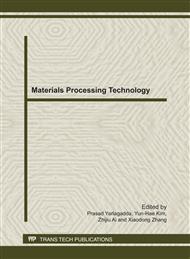p.274
p.281
p.285
p.289
p.294
p.300
p.307
p.313
p.319
An Optimization of the New Die Design of Sheet Hydroforming by Taguchi Method
Abstract:
During the last few years, several sheet hydroforming processes have been introduced. Despite the advantages of these methods, they have some limitations. Of the processes, the two main ones are the standard hydroforming and hydromechanical deep drawing. A new sheet hydroforming die set was proposed that has the advantages of both processes and eliminates their limitations. In this method, a polyurethane plate was used as a part of the die-set to control the blank holder force. This paper outlines the Taguchi optimization methodology, which is applied to optimize the effective parameters in forming cylindrical cups by the new die set of sheet hydroforming process. The process parameters evaluated in this research are polyurethane hardness, polyurethane thickness, forming pressure path and polyurethane hole diameter. The design of experiments based upon L9 orthogonal arrays by Taguchi was used and analysis of variance (ANOVA) was employed to analyze the effect of these parameters on the forming pressure. The analysis of the results showed that the optimal combination for low forming pressure is harder polyurethane, bigger diameter of polyurethane hole and thinner polyurethane. Finally, the confirmation test was derived based on the optimal combination of parameters and it was shown that the Taguchi method is suitable to examine the optimization process.
Info:
Periodical:
Pages:
294-299
Citation:
Online since:
September 2011
Authors:
Keywords:
Price:
Сopyright:
© 2011 Trans Tech Publications Ltd. All Rights Reserved
Share:
Citation:


